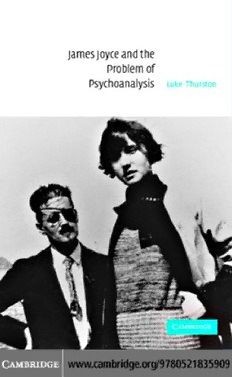
James Joyce and the problem of psychoanalysis PDF
Preview James Joyce and the problem of psychoanalysis
This page intentionally left blank JAMES JOYCE AND THE PROBLEM OF PSYCHOANALYSIS From its very beginning, psychoanalysis sought to incorporate the aestheticintoitsdomain,translatingitasvagrantsymptomorsubli- mateddesire.DespiteJoyce’sdeliberateattemptinhiswritingtoresist this powerful hermeneutic, his work has been confronted by a long traditionofpsychoanalyticreadings.LukeThurstonarguesthatthis very antagonism holds the key to how psychoanalytic thinking can stillopenupnewavenuesinJoyceancriticismandliterarytheory.In particular,ThurstonshowsthatJacquesLacan’sencounterwithJoyce forms part of an effort to think beyond the ‘application’ of theory: insteadofmerelydiagnosingJoyce’swritingorclaimingtohavedeci- phered its riddles, Lacan seeks to understand how it can entail an unreadable signature, a unique act of social transgression that defies translationintodiscourse.ThurstonimaginativelybuildsonLacan’s notionofJoyce’sirreducibleliteraryacttoilluminateJoyce’splacein a wide-ranging literary genealogy that includes Shakespeare, Hogg, Stevenson and Wilde. This study should be essential reading for all studentsofJoyce,literarytheoryandpsychoanalysis. luke thurston isaFellowofRobinsonCollege,Cambridge.He is the editor of Reinventing the Symptom: Essays on the Final Lacan (2002)andthetranslatorofseveralworksonpsychoanalysis,andhas publishedwidelyonmodernismandliterarytheory. JAMES JOYCE AND THE PROBLEM OF PSYCHOANALYSIS LUKE THURSTON RobinsonCollege,Cambridge cambridge university press Cambridge, New York, Melbourne, Madrid, Cape Town, Singapore, São Paulo Cambridge University Press The Edinburgh Building, Cambridge cb2 2ru, UK Published in the United States of America by Cambridge University Press, New York www.cambridge.org Information on this title: www.cambridge.org/9780521835909 © Luke Thurston 2004 This publication is in copyright. Subject to statutory exception and to the provision of relevant collective licensing agreements, no reproduction of any part may take place without the written permission of Cambridge University Press. First published in print format 2004 isbn-13 978-0-511-21042-6 eBook (ebrary) isbn-10 0-511-21042-6 eBook (ebrary) isbn-13 978-0-521-83590-9 hardback isbn-10 0-521-83590-9 hardback Cambridge University Press has no responsibility for the persistence or accuracy of urls for external or third-party internet websites referred to in this publication, and does not guarantee that any content on such websites is, or will remain, accurate or appropriate. In our culture – undoubtedly in others as well – discourse was not originallyathing,aproduct,orapossession,butanactionsituated inabipolarfieldofsacredandprofane,lawfulandunlawful,religious and blasphemous. It was a gesture charged with risks long before it becameapossessioncaughtinacircuitofpropertyvalues. MichelFoucault ‘SoIwasn’tdreaming,afterall,’shesaidtoherself, ‘unless–unlesswe’reallpartofthesamedream. OnlyIdohopeit’smydream...’ LewisCarroll,ThroughtheLooking-Glass Contents Acknowledgements pageix Anoteontextsandtranslations xi Listofabbreviations xii Prologue:GroundhogDay 1 part i on traduction 1 Anencounter 17 2 Freud’sMousetrap 31 3 Thepleasuresofmistranslation 55 part ii unspeakable joyce 4 HowamItosignmyself? 75 5 Egomenandwomen 104 6 God’srealname 149 Conclusion:mememormee 200 Notes 211 Bibliography 224 Index 230 vii ForPaulaandGeorge
